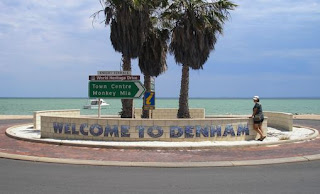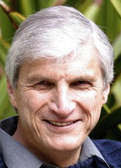 From Ceduna in South Australia, a Happy New Year to everyone!
From Ceduna in South Australia, a Happy New Year to everyone!We hope you finished the year on a good note and are optimistic about 2010.
Carol teeing off at the Dingo's Den hole near the Nullabor Roadhouse.
We're celebrating a big achievement: completion of the Nullabor Links, at 1,365 kilometres, the world's longest golf course.

We say goodbye to our vannie friends Wendy, Greg, Tony and Maureen in Perth.
The 'course', developed by Eyre Highway retailers, provides 18 holes designated at various roadhouses and towns from Kalgoorlie to Ceduna.
The unusual exercise broke up an otherwise long and tedious
 trip. But we must confess it's not an easy way to play golf.
trip. But we must confess it's not an easy way to play golf.The tee points are neatly set up on artificial grass beside a shelter shed, with a storyboard on local history to add interest.
Wave Rock, seen en route to Esperance.
The greens are mostly artificial grass and extremely fast. Unless you can emulate Greg Norman's back swing, you'll likely skid off into the undergrowth among the snakes and
 wombats.
wombats.But oh, the fairways! To call them goat tracks would be doing goats an injustice. Some were little more than patches of mulga.
Hay bales en route to Esperance.
But it was fun, even in temperatures reaching into the 40s and bush and march flies attacking from all quarters. For convenience we shared one set of clubs comprising a driver, 5-iron, 7-iron, wedge and putter.
Our cards, which cost $50 each, were duly stamped by roadhouse operators along the way. We won't mention our scores, but let's say they were well over the course's par 72.
We have to congratulate Carol for finishing, despite suffering unrelenting asthma contracted in Esperance -- more of that later.
Esperance was sublime

Vannies are often asked which place is the best they've visited. It's a hard question to answer.
View of Esperance from the west.
How do you compare, for example, Broome with the Gold
 Coast, the Kimberleys with Dunk Island, or Kakadu with the Whitsundays? All are exciting and memorable in their own way.
Coast, the Kimberleys with Dunk Island, or Kakadu with the Whitsundays? All are exciting and memorable in their own way.However, we found one place a standout. That is Esperance (pop. 30,000), facing Western Australia's southern ocean.
An unexpected warning sign.
Not the town itself, which is pleasant enough with its cafes and restaurants, port and intriguing Recherche Archipelago clearly visible a few kilome
 tres offshore, and the frequent appearance of a sea lion that flip flops up the beach near a jetty frequented by fishermen.
tres offshore, and the frequent appearance of a sea lion that flip flops up the beach near a jetty frequented by fishermen.What astonished us was the visually stunning coastline east and west of the town.
A regular visitor.
It's the grandeur and the colours: the sea changing from midnight blue to turquoise and emerald as it approaches and sloshes against white beaches and grey granite landforms shaped over millennia, and the lush hinterland speckled with wildflowers.
All can be enjoyed via a scenic roadway and viewing bays, access paths and stairway
 s to the beach.
s to the beach.Esperance can be hot, windy and cold -- all in one day -- but when the time is right, a swim at any one of dozens of beaches is just sublime.
Twilight Beach.
We felt at Twilight Beach it was like swimming in lemonade, so deliciously cool and clear was the water.

Beach at Cape le Grand.
We found more spectacular scenery a short drive east in the national park at Cape le Grand and at Duke of Orleans Bay, places that will live long in our memory.

Why the French names, you may ask?
Large and unusual rock formation at Cape le Grand.
It turns out the French Frigates Le Recherche, commanded by Bruni d'Entrecasteaux and l'Esperance (commanded by Huon de Kermadec) sought shelter from a storm in the archipelago in 1792. Their mission was to do scientific research
 and search for the lost explorer La Perouse, whom they never found.
and search for the lost explorer La Perouse, whom they never found.(The French Revolution was under way, but England's war with France would not commence until the following year).
Singing Rock at Cape le Grand, which deflects the sound of the waves at you.
We should add that credit for the first European visitor goes to (no prizes for guessing) a Dutchman: Pieter Nuyts, who sailed the Guide Zeepaard there in 1627, but did not actually land.

Duke of Orleans Bay.

Cape Barron geese at Esperance Golf Course where we played a round.
Gold! Gold! Gold!

Our departure from Esperance was delayed when Carol had an asthma attack accompanied by persistent coughing.
Exchange Hotel, Kalgoorlie.
We parked the van outside the local hospital and Carol was put on a nebuliser and had an x-ray. She was given some medication by a nurse practitioner and cleared for travel.
So off we went on a brief visit to gold mining town Kalgoorlie, 394km north via Norseman (the junction for travellers taking the Eyre Highway to and from South Australia) across the Nullabor.
Kalgoorlie is everything you've heard about. It's colourful and busy, with lots of old-style pubs and yes, brothels that are part of the town's tradition.
But what really surprised us was the number of large holes -- big gold mining holes -- that are everywhere around Kalgoorlie, from Norseman to Leonora.

The biggest is the Super Pit, an open cut mine 4km long, 1.5km wide and 600m deep that looks like the Grand Canyon, and is mined day and night by Kalgoorlie Consolidated Gold Mines (KCGM).
Kalgoorlie's Super Pit. The tiny specks on the roadway are massive ore trucks.
The Super Pit is the end result of an attempt by Alan Bond to buy up and consolidate a conglomeration of individual
 leases that once made up the famed Golden Mile, and create one big mine.
leases that once made up the famed Golden Mile, and create one big mine.Giant mining bucket at the Super Pit.
It was interesting to see the pipeline designed buy Charles O'Connor and built in 1903 to bring water more than 600km from Mundaring Weir near Perth to Kalgoorlie. It's still regarded as the lifeline to the gold fields.
(O'Connor suicided by shooting himself at Fremantle Beach a year before the pipeline was completed -- a terrible end for a brilliant engineer who apparently was subject to criticism by press, politicians and peers for no good reason).
Carol was fascinated by an apocryphal story about a woman who went for a pee on the roadside and washed the dust off something shiny that turned out to be a $300,000 nugget.
She wanted to rush out and hire a metal detector to try her luck.
I flatly refused to cooperate, a) because it was too hot, b) because there wasn't time and c) because you wouldn't know where to start looking. But she could go for a pee if she liked.
We had a brief look at Coolgardie, once a twin of Kalgoorlie but now just a tourist stop and almost a ghost town.

It's said that during the gold rush blocks in North Toorak, a suburb of Coolgardie, cost the pounds equivalent of almost $30,000 in the 1800s.
Warden's Court, Coolgardie
Today the suburb no longer exists and is described as 'arid land'. How fortunes can change!
As temperatures neared the 40s we had Christmas lunch hosted by the caravan park manager in a shady spot. As is the protocol, you brought your own chair and grog. We sat around a table of chicken, salad and nibbles.
The guests comprised a dozen vannies, 'permanents' and transient workers, all in singlets and shorts, who could have been mistaken for extras from some bizarre outback movie.
It was the first time we'd spent Christmas away from family. We left the lunch when they started telling 'abo' jokes.
Nullabor nightmare

After playing our first two holes of Nullabor golf in Kalgoorlie we hit the road on 27 December on a run that would take us across three time zones: Perth, Central Western and South Australian time.
Sculpture of the horse at Norseman that uncovered gold with his hoof, starting a gold rush.
After 400km we stayed overnight at Balladonia Roadhouse where we met a delightful couple, Nerilyn and Dennis from Rockhamp
 ton with whom later we would party on New Year's Eve in Ceduna.
ton with whom later we would party on New Year's Eve in Ceduna.Cliffs near Eucla on the Great Australian Bight.
We were now well and truly on the Nullabor crossing. The next stretch to Eucla included the longest 'straight' in Australia -- 90 miles or 141km. I must say the Eyre Highway is a fantastic piece of road, but you wouldn't want to break down in the heat between roadhouses that can be 200km apart.
At Eucla we inquired about medical assistance for Carol's cough, which was getting worse. The Flying Doctor, we were told, visited every week on a Wednesday. It being Tuesday, we decided not to wait and instead drive the 500km to Ceduna, which has a hospital and doctor.
I should mention that the Eucla Roadhouse is set on a ridge overlooking the Great Australian Bight and gets a cooling ocean breeze. The roadhouse provides power but no water for individual vans. You pay a dollar for a shower.
Eight kilometres on, just across the South Australian border, is a roadhouse with a sign that reads, 'Please do not ask for water as refusal often offends'. A joke it may be, but water is a scarce commodity in these parts.
As we all know, Nullabor is Latin (nulla arbor) for no trees. There are a few trees in some parts but when you arrive at the Nullabor Roadhouse there really are no trees: nothing but spinifex and mulga for miles.
After battling a headwind for 200km (that reduced our speed to 80km/hour) we made it into Ceduna, a town that reminds me of Carnarvon. I dropped Carol at the hospital and set up the van nearby at the Foreshore Caravan Park.
After a brief checkup, Carol was asked to call back the following day and report to the doctor at the Aboriginal Health Centre.
In the meantime, I got talking to a young guy with a black beard and only one top tooth camped nearby in a tent with his motorcycle in pieces. He told how his rear wheel bearings started disintegrating just out of the Nullabor Roadhouse.
Somehow he managed to get the back wheel going, moved his weight forward by sitting on the fuel tank and managed to limp into Ceduna virtually riding the front wheel.
Later he noticed Carol was using her asthma puffer and asked that if she were having a 'bong', could he come over and join us. Hmmm!
At the Health Centre the following day (when the temperature reached 44 deg) while I was waiting for Carol to emerge, an elderly Aboriginal woman with hair dyed pink came in.
Suddenly we heard a rooster crowing and she yelled: "Shut up!" and reached into her bag. I fully expected her to drag a cockerel out by the neck but instead she produced a mobile phone and began a conversation.
Every day is a new experience.
More news soon including an update on Carol's condition.











































